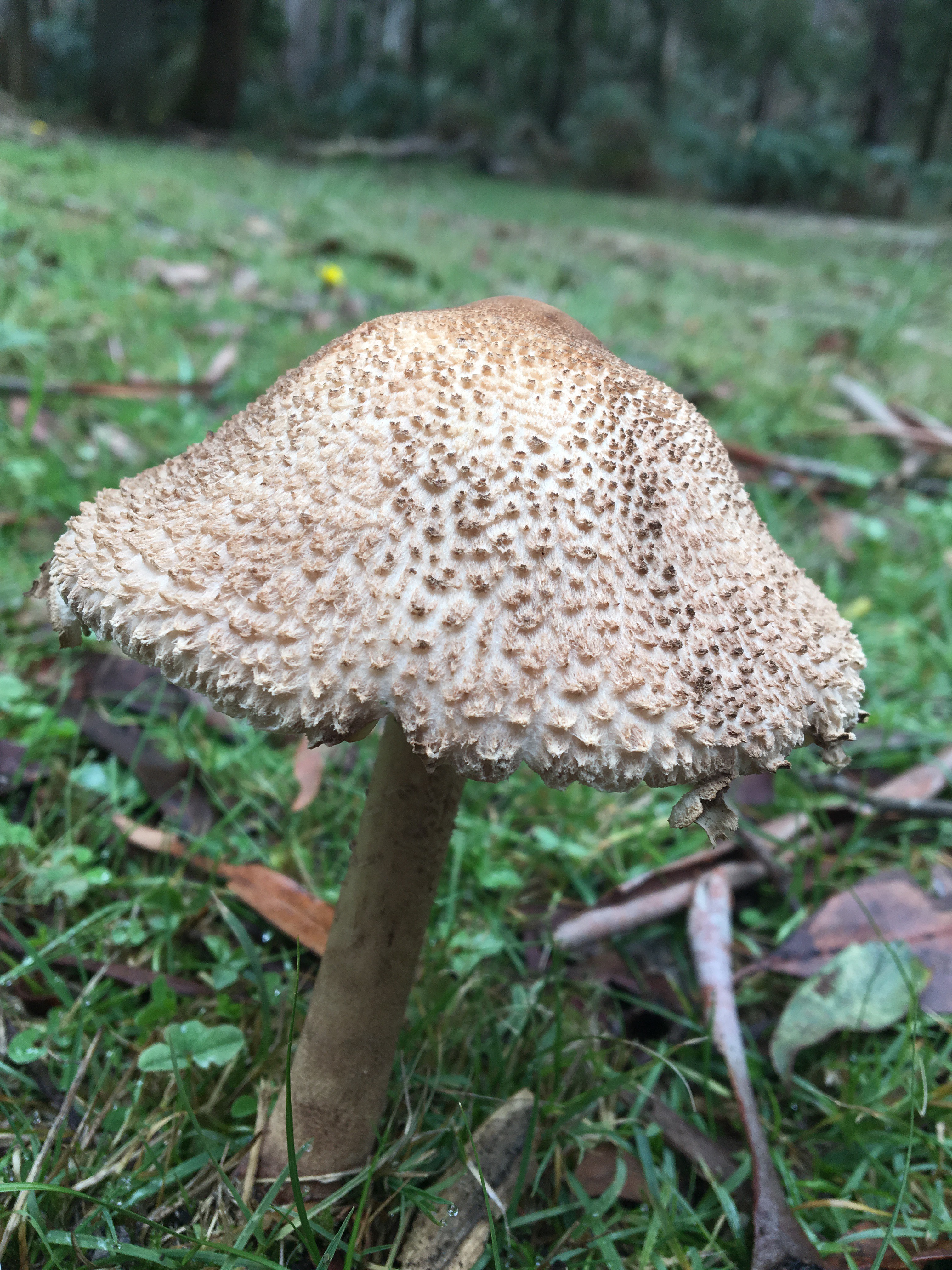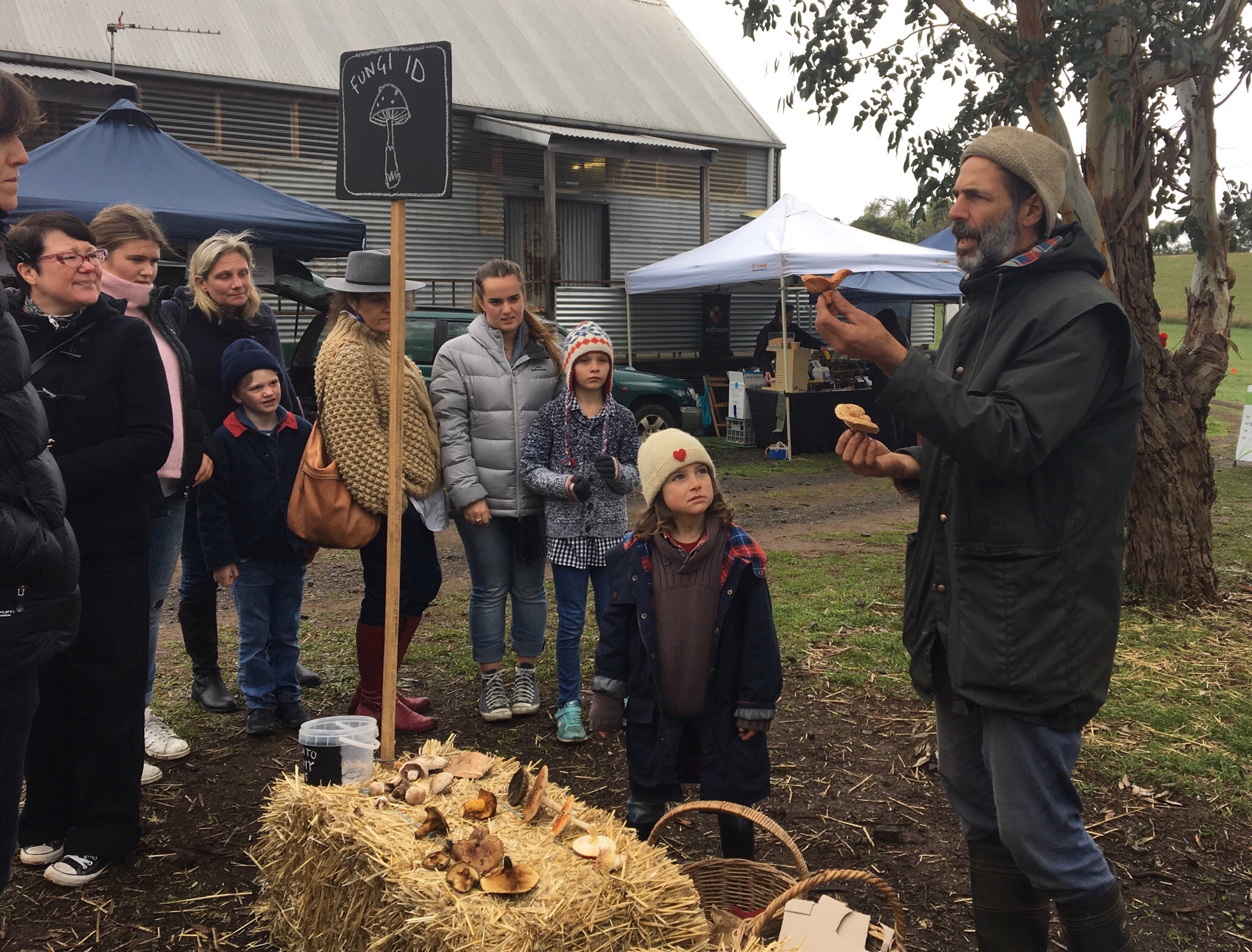In May and June, if there is enough rain, our gardens and local bushland are peppered with forms quite strange and wonderful – the sexual apparatus or fruiting bodies of fungi. Fungi are designated their own Kingdom, and their DNA is actually closer to animals than to plants. Long overlooked by the scientific community, the value and role of fungi on the planet Earth is slowly becoming apparent. Fungi are becoming regarded as a living matrix – a magical connector system between soil, minerals, and living things such as plants and animals.
The parasol form is the most common form – as it just works! The umbrella shape protects the gills and spores from rainfall, the stem raises the gills away from the ground or log. The fungus pictured is a classic example of this form, and indeed its common name is Parasol Mushroom. Most of our fungi species do not have common names, so it’s best to get used to Latin if you want to take up fungi spotting as a hobby. The Latin name for this species is Macrolepiota clelandii.

This fine specimen was photographed at Lyonville Springs in a group of three, growing from the soil, in a mix of native and introduced grasses, underneath some old candlebarks. Its identifying features are unseen in this photo, such as pale white gills and stem, and a ring of material around the stem known as an annulus.
If you are taking a photo for identification purposes, it is always a good idea to take a pic of the underside of the fungus – and many fungi fans carry a small mirror for this purpose. The use of a mirror means you can photograph the reflection of the underside of the mushroom, rather than pulling out the mushroom before its spores have shed. It seems a shame to destroy a fruiting body for identification!
I took the photo, as well as a few of its underside, to a fungi talk in Trentham on Saturday May 19. This was part of Wombat Forestcare’s fantastic speaker series known as “You, Me and Biodiversity”. May’s presenter was Dr Sapphire McMullan-Fisher, a passionate fungal ecologist who is giving a series of talks around Victoria on a new smartphone app for FungiMap, and a new citizen science project called “Lost fungi: help us find our uncommon Victorian fungi”. For this article, I will just be talking about the Fungi Map app.
FungiMap is a fungal mapping project that has been going for over twenty years, and involves members of the community reporting on 100 recognisable target species. The new app runs through a global citizen science database called iNaturalist, and the FungiMap Australia project is one of many thousands of projects running globally.
I will be downloading the app, and having a go, as this project is in the testing phase, and Sapphire and the team welcome any feedback to make the use of the app as easy as possible. Unlike local biodiversity apps such as Bowerbird, or the Atlas of Living Australia app, the iNaturalist app uses an algorithm to help the person submitting a photo identify it automatically – sometimes to genus level! The link to get to the project is https://www.inaturalist.org/projects/fungimap-australia , but it helps if you download the iNaturalist app first and get your log in sorted.
In terms of identifying fungi, Sapphire says it’s best to start with recognisable species, and then go from there. Another point emphasised is that you really are best to start with LOCAL fungi guides, such as the foldout brochure that Wombat Forestcare produced. This is because 72% of our fungi are endemic to Australiasia, that is found nowhere else. So an online search could come up with similar looking species in other countries which are actually totally unrelated.

Inevitably, someone asked about how can we find out about the fungi that is safe to eat locally. Sapphire said we must be very cautious as so much is unknown about our fungi – and the best way to find out is to ask a trusted local expert. And lucky for us – we have one! In the spirit of locavore foraging, Patrick Jones is at the Daylesford Sunday Farmers Market every Sunday from 10am-noon in the month of May. Patrick presents a very informative talk and mushroom display each week, with mushrooms that he and his son Woody have collected locally. And you can bring in any species you are unsure about, and need identification.
Another incredible community expert is the wonderful Alison Pouliot – I could not post about fungi without mentioning Alison. Alison is a professional photographer and educator, and a damn fine writer too! See Alison’s work and notice of upcoming workshops at her website https://alisonpouliot.com/
Hi Kate! Yes I did! That is actually patrick and his son Woody – he has long hair ❤️ Great little team xx
Many thanks Tanya, did you take the photo of Patrick today? Same little girl with the love heart on her beanie was there and fungi set out just like that Cheers Kate
On Sun, 20 May 2018 4:46 pm From forest to forest wrote:
> Tanya Loos posted: “In May and June, if there is enough rain, our gardens > and local bushland are peppered with forms quite strange and wonderful – > the sexual apparatus or fruiting bodies of fungi. Fungi are designated > their own Kingdom, and their DNA is actually closer to an” >
Reblogged this on kentlburgess.